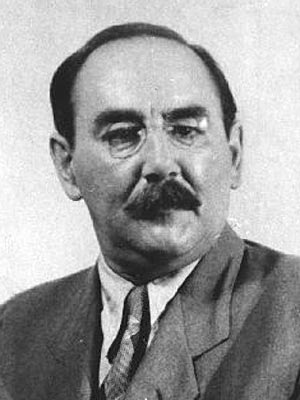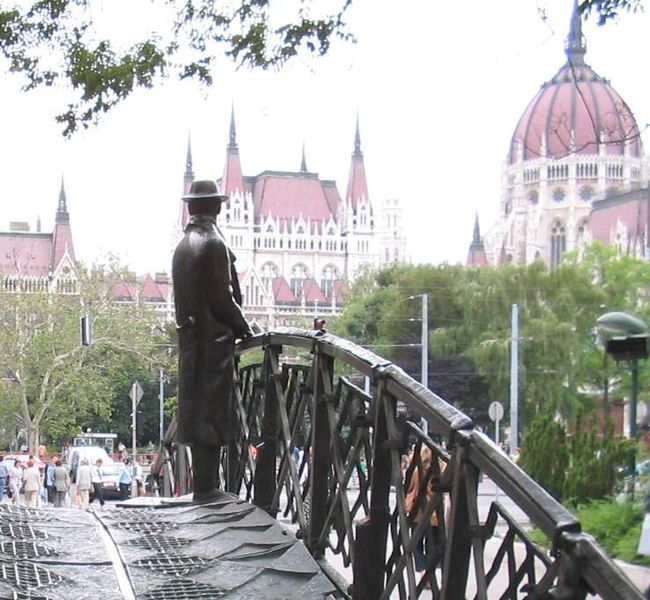<Back to Index>
- Physicist Philipp Eduard Anton von Lenard, 1862
- Painter Eugène Henri Paul Gauguin, 1848
- Chairman of the Council of Ministers of the People's Republic of Hungary Imre Nagy, 1896

Imre Nagy (June 7, 1896 – June 16, 1958) was a Hungarian politician, appointed Prime Minister of Hungary on two occasions. Nagy's second term ended when his non-Soviet-backed government was brought down by Soviet invasion in the failed Hungarian Revolution of 1956, resulting in Nagy's execution on charges of treason two years later.
Nagy was born in Kaposvár, to a peasant family and was apprenticed to a locksmith. He enlisted in the Austro-Hungarian Army during World War I and served on the Eastern Front. He was taken prisoner in 1915. He became a member of the Russian Communist Party, and joined the Red Army. Nagy returned to Hungary in 1921. In 1930 he travelled to the Soviet Union and joined the communist party. He was engaged in agricultural research, and also worked in the Hungarian section of the Comintern. He was expelled from the party in 1936 and later worked for the Soviet Statistical Service. Rumours that he was an agent of the Soviet secret service surfaced later, begun by Hungarian party-leader Károly Grósz in 1989 in an attempt to discredit Nagy. There is evidence, however, that Nagy did serve as an informant for the NKVD during his time in Moscow and provided names to the secret police as a way to prove his loyalty (not an uncommon tactic for foreign communists in the Soviet Union at the time).
After the war Nagy returned to Hungary. He was the Minister of Agriculture in the government of Béla Miklós de Dálnok, delegated by the Hungarian Communist Party. He distributed land among the peasant population. In the next government, led by Tildy, he was the Minister of Interior. At this period he played an active role controlling the expulsion of Germans. In the Communist government, he served as Minister of Agriculture and in other posts. He was also Speaker of the National Assembly of Hungary 1947-1949.
After
two years as Prime Minister (1953–1955), during which he promoted his
"New Course" in Socialism, Nagy fell out of favour with the Soviet
Politburo. He was deprived of his Hungarian Central Committee,
Politburo and all other Party functions and on April 18, 1955, he was
sacked as Prime Minister. Nagy became Prime Minister again, this time by popular demand, during the anti-Soviet revolution in 1956. Soon he moved toward a multiparty political system. On 1 November, he announced Hungary's withdrawal from the Warsaw Pact and
appealed through the UN for the great powers, such as the United States
and the United Kingdom, to recognize Hungary's status as a neutral
state. Throughout
this period, Nagy remained steadfastly committed to Marxism; but his
conception of Marxism was as "a science that cannot remain static", and
he railed against the "rigid dogmatism" of "the Stalinist monopoly". When the revolution was crushed by the Soviet invasion of Hungary, Nagy, with a few others, was given sanctuary in the Yugoslav Embassy. In spite of a written safe conduct of free passage by János Kádár, on 22 November, Nagy was arrested by the Soviet forces as he was leaving the Yugoslav Embassy, and taken to Snagov, Romania.
Subsequently, the Soviets returned him to Hungary, where he was
secretly charged with organizing to overthrow the Hungarian people's
democratic state and with treason. Nagy was secretly tried, found
guilty, sentenced to death and executed by hanging in June, 1958. His trial and execution were made public only after the sentence was carried out. According to Fedor Burlatsky, a Kremlin insider, Nikita Khrushchev had Nagy executed, "as a lesson to all other leaders in socialist countries." He was buried along with others in a distant corner (section 301) of the Kozma Street Municipal Cemetery outside Budapest. During
the time when the Communist leadership of Hungary would not permit his
death to be commemorated, or permit access to his burial place, a cenotaph in his honor was erected in Père Lachaise Cemetery in Paris.
In 1989, Imre Nagy was rehabilitated and his remains reburied on the
31st anniversary of his execution in the same plot after a funeral
organized in part by opponents of the country's communist regime. Over
100,000 people are estimated to have attended Nagy's reinterment. The
occasion of Nagy's funeral was an important factor in the end of the
Communist government in Hungary. The
collected writings of Nagy, most of which he wrote after his dismissal
as Prime Minister in April 1955, were smuggled out of Hungary and
published in the West under the title "Imre Nagy on Communism". Nagy was married to Mária Égető. The couple had one daughter, Erzsébet Nagy (1927-2008), a Hungarian writer and translator. Erzsébet Nagy married Ferenc Jánosi.
Imre Nagy did not object to his daughter's romance and eventual
marriage to a Protestant minister, attending their religious wedding
ceremony in 1946 without Politburo permission. In 1982, Erzsébet
Nagy married János Vészi.

